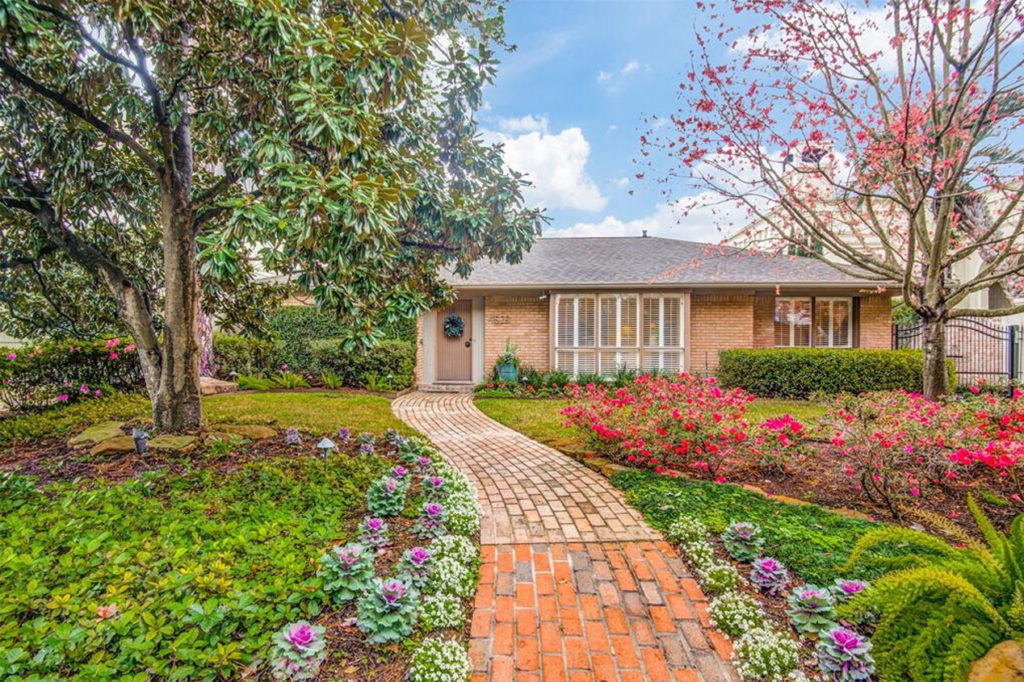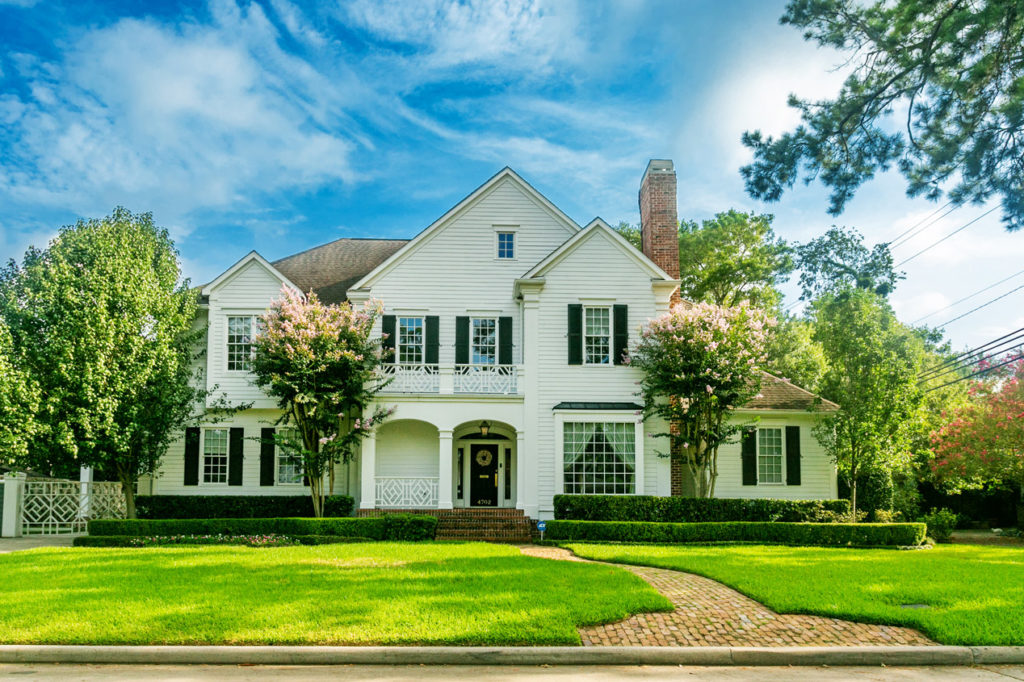History
Afton Oaks had its beginnings in the early 1950’s, when the subdivision was laid out south of Westheimer. At that time Westheimer was unpaved, with ditches on either side. Westheimer virtually ended at Post Oak, and there was a thriving nursery where Le Peep restaurant was until recently—but now is the site of a major multi-use development. Loop 610 did not exist, and a schoolhouse occupied the corner where Galleria One now stands. Highland Village was very low key, with a drug store, hardware store, and a down-to-earth Weiner’s department store, which became Tootsies selling very upscale women’s clothing.
Although we usually think of Afton Oaks as a single entity between the Southwest Freeway and Westheimer, and the Loop and Mid Lane, it is actually a collection of nine different subdivisions. Bryn Mawr and Ivanhoe streets are in what is called “Kettering Oaks” and “Greenwood Addition” lies to the west of Kettering. The other sections of Afton Oaks are numbered from One to Seven.
Common deed restrictions bound the subdivision sections together until very recently, when Section Seven regrettably allowed its restrictions to lapse, and multiple dwellings were built shortly thereafter. The two most crucial elements of the common deed restrictions prohibit commercial activity in the neighborhood, and limit occupancy to one single-family residence per lot.
Construction in Afton Oaks began with a few homes on the northern end in 1953. One of the original Afton Oaks home builders built his residence on Ivanhoe at that time and his home and lot cost the grand sum of $27,000! That house has since been replaced by new construction.
Twenty years later, by the 1970s, Afton Oaks was largely covered with houses. Loop 610 opened in 1971 and, along with Westheimer expansion, invited access to the Galleria and West Houston like never before. In 1970 one could travel west from the Galleria to Highway 6 in ten minutes, encountering only four stop lights along the way.
Housing values in Afton Oaks were still a bargain in the early 70s. A three bedroom, two and a half bath house on West Alabama, just east of Kettering, sold for $38,500 in 1970. By the mid-70s houses on Ivanhoe had reached the $100,000+ level, and there were few vacant lots left in Afton Oaks.
During this early period Afton Oaks was establishing itself as the gracious residential neighborhood that we now enjoy. The magnificent Live Oak trees on the Newcastle esplanade had been planted in the 70s, but they were so small that iron pipes were driven into the ground to keep them from being run over by cars. We had back door garbage pickup, but our garbage service was a mom-and-pop business consisting of one driver, two helpers, and a very old garbage truck. The truck broke down constantly, and twice weekly back door service was hit or miss. One day the disabled garbage truck was towed through the neighborhood by the owner’s pickup!
With the growth of surrounding commercial interests, chiefly the Galleria, Afton Oaks began to experience a period of commercial siege. The Galleria was looking for ways to get traffic in and out more rapidly, and they tried to promote a West Alabama tunnel under Loop 610 and a bridge over the railroad tracks: a twin traffic disaster for our subdivision. Fortunately, cost considerations kept those ideas from becoming a reality.
There was another plan to connect both ends of Newcastle Street at the Southwest Freeway which would have brought Bellaire traffic through our neighborhood to Richmond and beyond. Luckily, with our encouragement, TxDot built a formidable sound wall there and effectively killed the idea. But other threats would emerge.
The City of Houston decided that Richmond Avenue was the perfect place to put a light rail line from downtown to the West Loop. This rail line was to be elevated, with huge pylons supporting the track at close intervals. Our lovely oak trees along Richmond were going to be ripped out to make room for the rail. Several major companies were bidding on the job, and it was awarded to the front runner. During the planning stages, however, neighborhood resistance focused on the project, and a coalition was established to fight it. “No Rail on Richmond” was our rallying cry, and we were joined by residential groups from Montrose to the Loop.
The protest reached its zenith when Afton Oaks erected a life-size replica of a rail pylon built of plywood on the Richmond esplanade at Newcastle. This was a massive structure, twenty feet high, and twelve feet in diameter, with simulated tracks extending east and west and painted concrete gray–just like the real thing. We had a noisy rally one Saturday afternoon, with lots of press and television coverage, and everyone wearing “No Rail on Richmond” buttons. Residents decorated the pylon with graffiti, just as would eventually happen to the real structures. The grass roots effort was successful; rail on Richmond was defeated, but the idea has not died: urban planners and METRO still covet Richmond as a light rail or dedicated bus corridor.
By the 1980s Afton Oaks streets and storm sewers were causing serious problems. The subdivision had been laid out with a storm drainage system that proved inadequate to handle the water run-off from large downpours. As the years went by pipes were cracked and broken underground by shifting soils, and the result was street flooding even during a mild storm. It was not unusual for residents in many parts of Afton Oaks to wait several hours before they could leave or return to their homes because of flooding in the streets.
Twenty years ago, the Afton Oaks Civic Club began an effort began to replace the streets and storm sewers with new construction. This was not a simple task. Municipal offices did not communicate well with one another; it was difficult to get them in the same room, much less to agree on how to solve the problem. We were told several times by the City that the drainage problem was caused by neighbors stuffing their leaves down the sewers!
Endless meetings were held, as we cajoled City officials in private and attended public discussions. Then we had to get on the Capital Improvement Project list and get the necessary money set aside for this new construction. Our struggle took fully twenty years and lasted through the terms of several City Council members who represented Afton Oaks and were critically important in getting this project to fruition.
Eventually, in the spring of 2000, the City finished plans for the $17 million total reconstruction of streets and sewers that we are now enjoying in Afton Oaks. Actual construction began September of 2000, and Phase I was complete by February of 2002. Phase II commenced September 2002, and was finished in June 2004– three months ahead of schedule.
Maintaining our residential lifestyle requires constant vigilance. Afton Oaks has been fortunate to have vigorous, active volunteercitizens serving on the Board of Directors of the Civic Club over the past fifty years who have championed our causes and continue to do so. For example, we were able to block off Ivanhoe and West Alabama from Loop 610, reducing cut-through traffic from the Loop 610 feeder road. Other traffic measures such as speed bumps were installed more recently, and we were able to work out an agreement with the developer of River Oaks District, so that traffic from that project will be deterred from entering our neighborhood from the north.
Afton Oaks is undergoing enormous change as new construction replaces many of the smaller, seventy-year old houses all over the neighborhood. Lot values are in the $800,000 plus range, and the average price of a house in Afton Oaks is around $300 per square foot. In 2004, there were five houses for sale priced from $1.2 to $1.5 million, today there are many houses listed for more than $2 million. Recognizing that change will occur, we are working hard to ensure that quality-of-life remains foremost in our planning. We want Afton Oaks to be a wonderful place to live for the next seventy years! by Christian Seger


